Narnia Chess
Narnia Chess is a further development of my earlier game, Chess on a Soccer Ball. The game is played on both the outside and inside of a soccer ball, with the 12 pentagons serving as "gateways" between the two sides. Along with the 12 pentagons, there are 40 hexagons - 20 on each side, making 52 cells altogether.Players of Alice Chess with recognize the similarities - it's like having two boards, with pieces able to move from one to the other.
The name and the idea come from C.S. Lewis's novels, "Chronicles of Narnia". Remember the wardrobe? and the magic picture frame? These and other "gateways" allowed passage from Earth to Narnia. One could also recall Jack L. Chalker's "Wellworld" science-fiction novels : there was a gateway at the pole of many planets, allowing people to travel to the Wellworld. The pentagons in this game serve a similar purpose.
Setup
Note: in the notation, cells named with lower-case letters (z1, y2, etc.) denote the outer surface of the soccer ball. Those named with upper case letters (Z1, Y2, etc.) denote the inside of the ball.Centred Version - in this version, there is one Wizard and two of every other kind of piece.
WHITE: - Wizard - Pentagon L - Satellite - Hexagon z0 and Z0 - Bishop - Hexagon z1 and Z1 - Rook - Hexagon z2 and Z2 - Knight - Hexagon z3 and Z3 - Ringmaster - Hexagon z4 and Z4 - King - off-board, as in Chess on a Soccer Ball.
BLACK: - Wizard - Pentagon A - Satellite - Hexagon x0 and X0 - Bishop - Hexagon x1 and X1 - Rook - Hexagon x2 and X2 - Knight - Hexagon x3 and X3 - Ringmaster - Hexagon x4 and X4 - King - off-board, as in Chess on a Soccer Ball.
Figure 1: Default setup (Centred Version). Note that in this and other images, pieces shown as upside down are on the "inner" surface of the soccer ball, whereas those right-side up are on the "outer" surface. Any piece on a pentagon is simultaneously on both surfaces.
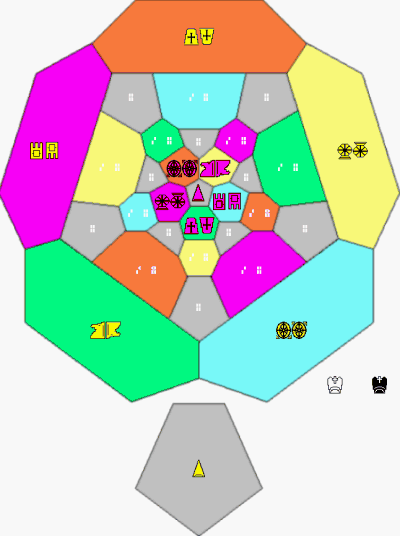
Symmetrical Version - in this variant, each player has two of every kind of piece.
WHITE: - Wizard - Pentagon K and L - Satellite - Hexagon z0 and Y7 - Bishop - Hexagon z1 and Y6 - Rook - Hexagon z2 and Y5 - Knight - Hexagon z3 and Z3 - Ringmaster - Hexagon z4 and Z4 - King - off-board, as in Chess on a Soccer Ball.
BLACK: - Wizard - Pentagon A and B - Satellite - Hexagon x0 and Y2 - Bishop - Hexagon x1 and Y1 - Rook - Hexagon x2 and Y0 - Knight - Hexagon x3 and X3 - Ringmaster - Hexagon x4 and X4 - King - off-board, as in Chess on a Soccer Ball.
Figure 2: Symmetrical Version setup
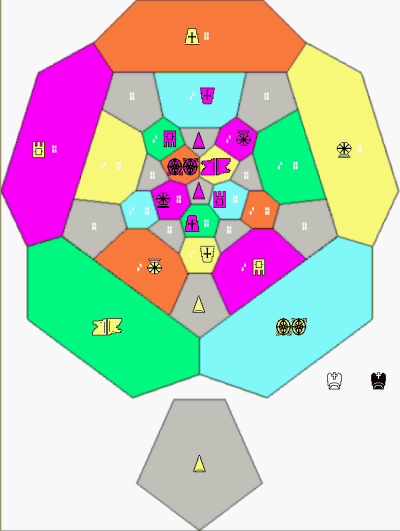
Pieces
King - this piece is inspired by the Goal in Klinzha. The King, who begins the game off-board, has no movement powers of his own (except on the first move of the game) and must be carried by another piece. The first move of the game is, therefore, to move the King on top of the piece that will carry him. The Zillions version treats the King and the piece carrying him as a single piece. The Royal Rook, Royal Bishop, Royal Knight, Royal Ringmaster, Royal Satellite, and Royal Wizard are the resulting pieces. Each royal piece retains the movement capabilities of its simple form, but may not move into or through check.Rook - rides any number of cell along a straight path between two pentagons.
Figure 3: showing the moves of the Rook.
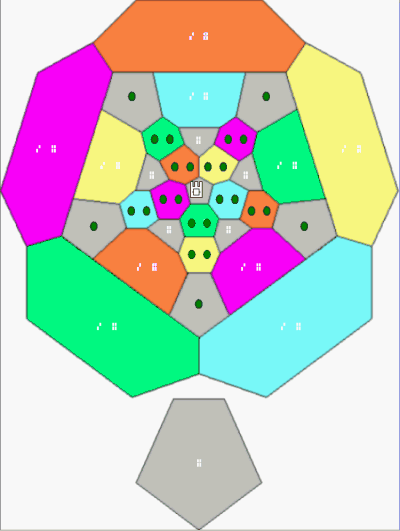
Bishop - rides in diagonal loops - defined as hexagonal cells connected by a line between two other cells. Players of many hexagonal chess variants will recognize this piece.
Figure 4: showing the moves of the Bishop.
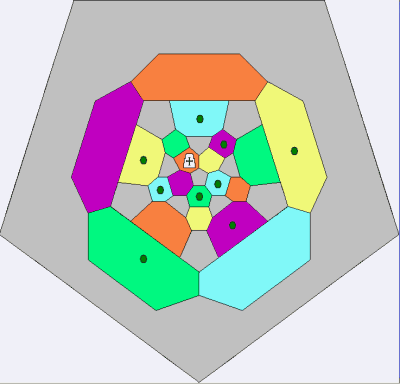
Wizard - rides in pentagonal loops - defined as pentagonal cells connected by a line between two hexagonal cells. The Wizard moves on pentagons much as the Bishop does on hexagons, and was inspired by the hexagonal bishop.
Figure 5: showing the moves of the Wizard.

Knight - leaps (a) from one hexagon to another hexagon three cells away, (b) from a hexagon to a pentagon three cells away, or (c) from a pentagon to a hexagon three cells away.
Figure 6: showing the Knight's move, from hexagons

Figure 7: showing the Knight's move, from pentagons
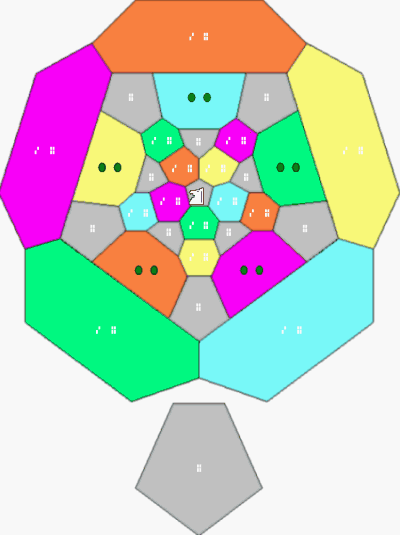
Ringmaster - rides in hexagonal loops around a single pentagon. As each hexagon is adjacent to three pentagons, a Ringmaster may move in any one of three directions.
Figure 8: showing the moves of the Ringmaster
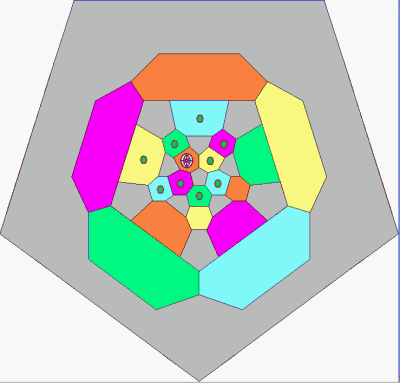
Satellite - rides in crooked hexagonal loops around "equators", i.e., paths that divide the board equally in two. Each "equator" consists of ten hexagons and has five hexagons and six pentagons on either side of it.
Figure 9: showing the moves of the Satellite
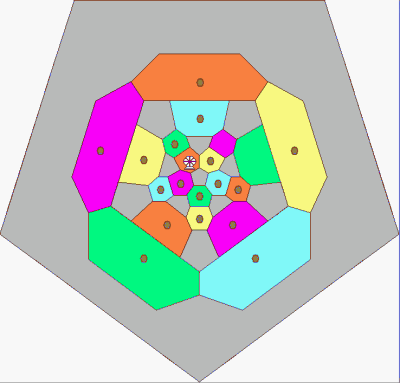
Pawn - moves one cell without capturing on hexagons, or captures by moving one cell from a hexagon to a pentagon, on which it morphs into a Guard. The Pawn, unlike its FIDE counterpart, may move backward or sideways as well as forwards. At the beginning of the game, every Pawn stands on top of another piece and must move off before that piece can move. The Pawn may not attack a royal piece (i.e., a piece carrying the King).
Figure 10: showing the passive moves (green dots) and the capturing moves (red dots) of the Pawn.

Guard - moves one cell without capturing on pentagons, or captures by moving one cell from a pentagon to a hexagon, on which it morphs into a Guard. At the beginning of the game, the Guard stands on top of the Wizard, and must move off before the Wizard can move. The Guard may not attack a royal piece (i.e., a piece carrying the King).
Figure 11: showing the passive moves (green dots) and capturing moves (red dots) of the Guard.

Hidden pieces - pieces with Pawns or Guards on top of them, and are paralyzer until the Pawn or Guard moves off. N.B. If you are playing Zillions, the yellow and red pieces in the initial setup are really white and black pieces, respectively, with Pawns or Guards on them. When the Pawn or Guard moves off, the piece left behind will change colour.
Royal pieces - ordinary pieces that are carrying a King. In Zillions, when the King mounts a piece, a crown appears above it.
Rules
Same as in Chess on a Soccer Ball, except as follows:1. The Wizard may not caputre another Wizard. This is because in the initial setup, the Black and White Wizards on Pentagons K and A, and on L and B, attack each other. If allowed to do so, a white Wizard could capture its black counterpart on the first move, giving a heavy advantage to white.
As the Wizard is one of the pieces that can move between the two sides of the board, I think the game might be all over too quickly if one Wizard was able to capture another, and whichever side managed to make the capture would have an almost insurmountable advantage.
2. The Wizard, riding on pentagons, is on both sides of the board simultaneously. The Rook and Knight may move from one side to the other. The Bishop, Ringmaster, and Satellite are confined to one side of the board, and thus serve a defensive purpose. Pawns are confined to one side of the board when moving passively (on hexagons), but may cross over when making captures (on pentagons). On moving to a pentagon, a Pawn morphs into a Guard, which moves on pentagons, but captures on hexagons (on either side of the board). On moving to a hexagon, a Guard changes back into a Pawn again.
Notes
The game is won by checkmate, stalemate, or baring the king.I have programmed a Zillions of Games file for this variant. You may download it here.
* Free distribution of this game is permitted - and, in fact, encouraged - for any noncommercial purpose.
* You have Zillions experience? Feel free to optimise the code, correct any bugs, create variants for this game, or even use ideas (including code) from this program in games of your own. You may email me
with suggestions. If I use your suggestions in future editions, I will acknowledge you. This 'user submitted' page is a collaboration between the posting user and the Chess Variant Pages. Registered contributors to the Chess Variant Pages have the ability to post their own works, subject to review and editing by the Chess Variant Pages Editorial Staff.
This 'user submitted' page is a collaboration between the posting user and the Chess Variant Pages. Registered contributors to the Chess Variant Pages have the ability to post their own works, subject to review and editing by the Chess Variant Pages Editorial Staff.
By David Cannon.
Web page created: 2009-02-22. Web page last updated: 2009-02-22